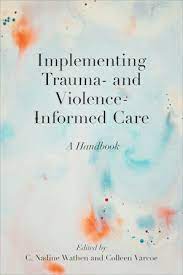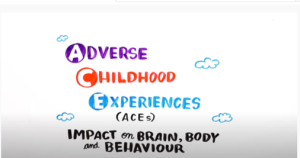Our new Handbook consolidates core concepts and lessons learned from TVIC implementations across settings and sectors:
Wathen, C.N., Varcoe, C.M. (Eds). (2023). Implementing Trauma- and Violence-Informed Care: A Handbook. Toronto, University of Toronto Press. ISBN: 9781487529253.
- Available to order here

For additional free learning and practice resources, click the headings below.
TVIC Tool for Health & Social Services – a 3-page overview of TVIC and how to implement the 4 Principles in organizational and individual practice, with a printable summary poster as page 4.
Principles of Trauma- and Violence-Informed Care (graphic) – a one page graphic summary of the 4 Principles of TVIC and strategies for organizations and individual providers.
Trauma- & Violence-Informed Care Strategies for Staff Well-Being – a 4-page graphic tool defining vicarious trauma and moral distress and providing ways to recognize and respond to them, with emphasis on organizational strategies to support staff.
Rate Your Organization: Organizational Strategies to Promote Staff Safety and Well-Being – Use this 3-page tool to rate how well your team, unit, or organization supports staff safety and well-being according to 10 strategies.
TVIC Strategies for (Re)Establishing Safety in Care Encounters – Interactions can become unsafe when service users experience a trauma response. The strategies on this 2-page graphic brief can help you prevent, prepare for, and appropriately respond to difficult situations.
Trauma Review Exercise – guides an actual (or mental) ‘walk through’ of the physical and social spaces where services are provided. Are they welcoming? physically, culturally and emotionally safe? Creating safe and welcoming spaces reduces potential harm for everyone, especially those most likely to feel unwelcome and unsafe. The space can be anywhere you provide service (e.g. in an office, school, clinic, hospital, community center, a home) – it applies to interactions with individuals and groups.
Trauma- and Violence Informed Care: Prioritizing Safety for Survivors of Gender-Based Violence – a 6-page “backgrounder” (with reference list) describing core concepts and principles of TVIC and why TVIC is essential to caring for those experiencing GBV.
Intimate Partner Violence Journeys to Safety – framed as guidance for those wishing to be good formal or informal allies or helpers, this 7-page graphic document synthesizes qualitative research on women’s experiences when making decisions about their abusive relationships.
Wathen, C.N., Mantler, T. (2022). Trauma- and Violence-Informed Care: Orienting Intimate Partner Violence Interventions to Equity. Current Epidemiology Reports. Online first (open access): https://doi.org/10.1007/s40471-022-00307-7
The following free educational resources include embedded videos, case-based activities, downloadable Notebooks for reflection and links to key take-aways, and interactive quizzes throughout. After successfully completing a brief assessment, learners can download a Certificate of Completion.
Trauma- and Violence-Informed Care (TVIC) Foundations Curriculum
This education is for anyone who wants to increase their knowledge and skills when working with people seeking care in health care, social services and beyond. It also supports leaders in developing policies and protocols to support TVIC practice.
Access this free e-learning education here.
Trauma- and Violence-Informed Care (TVIC) Public Health Nurse Home Visiting & Outreach Curriculum
This education is for anyone who wants to increase their knowledge and skills when working with young babies and families. It also supports leaders in developing policies and protocols to support TVIC practice.
Access this free e-learning education here.
Creating Safe Connections: Practical Strategies to Support Lung Cancer Screening Conversations
This course is for any provider who wishes to learn how to apply TVIC principles in conversations about screening for lung cancer, and about lung cancer risks such as smoking. It also supports leaders in developing policies and protocols to support TVIC practice.
Access this free e-learning education here.
Wathen, C.N., MacGregor, J.C.D., Beyrem, S. (2021). Impacts of Trauma- and Violence-Informed Care Education: A Mixed Method Follow-Up Evaluation with Health & Social Service Professionals. Public Health Nursing. Online: https://onlinelibrary.wiley.com/doi/abs/10.1111/phn.12883
Rodger, S., Bird, R., Hibbert, K., Johnson, A., Specht, J., Wathen, N. (2020). Preparing teachers to teach all students: Initial teacher education and trauma and violence informed care in the classroom. Psychology in the Schools, 57(2), 1798-1814. http://dx.doi.org/10.1002/pits.22373.
Access the TVIC Core Competency Framework here. The courses and resources above are designed to articulate and operationalize these competencies for various health, social service and education providers.
This graphic tool, which describes how to integrate TVIC into client and public-facing educational efforts, was developed by Jessica Carswell and our GTV Incubator team in partnership with the Canadian Mental Health Association, Elgin-Middlesex. There are two versions, one with locally-relevant resource links, and one more generic for those outside the London-Middlesex and Elgin (Ontario) region:
This whiteboard “explainer” video, developed by Dr. Andrea Gonzalez at McMaster University with support from the PreVAiL Research Network, shows the impact of Adverse Childhood Experiences, including trauma and violence, on the developing brain.
 Click here to view the video on YouTube
Click here to view the video on YouTube
The following resources have been developed by Dr. Susan Rodger to support teacher education. They are provided as PDF files; for more information, please contact Dr. Rodger.
This resource can support applying TVIC thinking in higher education settings:
-
- Wathen, C.N., Schmitt, B., MacGregor, J.C.D. (2023). Measuring Trauma- (and Violence-) Informed Care: A Scoping Review. Trauma, Violence & Abuse, 24(1), 261-277. (open access) https://doi.org/10.1177/15248380211029399
- brief graphic summary of key findings
-
- This project, funded by SSHRC, is evaluating in Rwanda and Canada a new TVI Knowledge Mobilization (TVI-KMb) Protocol.
-
- Wathen, C.N. (2022). Mobilizing knowledge for complex social problems: Lessons learned from gender-based violence research. The Annual Review of Interdisciplinary Justice Research, 11, 117-127. https://www.cijs.ca/volume-11
-
- Research Summary: Naeemzadah, N., & Wathen, C. N. (2023). How Canadian news media framed intimate partner violence during the pandemic and why it matters. London, Canada.
Visit the EQUIPHealthcare.ca TVIC Resources page for additional applications of TVIC as a key dimension of equity-oriented care, including the EQUIP Equity Action Kit.